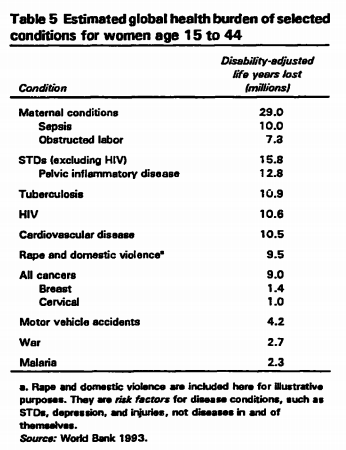Are women more at risk from violence than from cancer, car accidents and malaria combined?
"Women aged 15-44 are more at risk from rape & domestic violence than from cancer, car accidents, war & malaria combined."
Various sources, retweeted extensively on Twitter
The recent killing of six people in California by Elliot Rodger sparked a great deal of discussion on Twitter over the weekend, after he posted a video on YouTube ahead of the attacks "railing against women".
One claim that the discussion threw up has been around - in various forms - for at least 14 years, based on a source that's now 20 years old.
The claim as quoted above is inaccurate, in so far as it's based on the same research. One study from 1994 suggested that rape and domestic violence could account for about as many years of life lost for women in this age group as cancer, and - separately - more than motor accidents, war and malaria combined.
Even then, the original author of the research warned Full Fact that the claim should not be used in its current form, and that more recent research has called these findings into question.
Join 72,953 people who trust us to check the facts
Sign up to get weekly updates on politics, immigration, health and more.
Subscribe to weekly email newsletters from Full Fact for updates on politics, immigration, health and more. Our fact checks are free to read but not to produce, so you will also get occasional emails about fundraising and other ways you can help. You can unsubscribe at any time. For more information about how we use your data see our Privacy Policy.
Prominent and misunderstood
The United Nations website is among the most prominent places to use the claim, although here it's stated ambiguously: it's not clear whether rape and domestic violence account for greater 'risk' to women than the other factors combined, or just more than each of them separately.
But the former United Nations Development Fund for Women (now part of UN Women) and the World Health Organisation put forward a significantly different version:
"Worldwide, it has been estimated that violence against women is as serious a cause of death and incapacity among women of reproductive age as cancer, and a greater cause of ill-health than traffic accidents and malaria combined"
Back to 1994
A discussion paper from 1994, uncovered during a discussion on the Feminist Critics blog at the start of this year, appears to be the original source of the claims.
The research took data from the World Development Report 1993, which compiled estimates of the years of life people lose through premature death combined with the number of healthy years of life people lose through disability (called 'disability-adjusted life years - or DALYs). These are attributed to different diseases or incidents.
Among women aged 15-44, cancers were estimated to have resulted in a total of nine million life years lost, while 4.2 million were lost due to motor accidents, 2.7 million to 'war' and 2.3 million to malaria. All this is put alongside an estimated 9.5 million lost to rape and domestic violence.
So the research never suggested that rape and domestic violence exceeded all the other factors combined in terms of life years lost.
Problems with interpretation
Even on more careful interpretations of the figures, however, there are a number of reasons to be cautious.
First of all, the figures don't compare like-with-like. Cancer, malaria and road accidents are often direct causes of death, but rape and domestic violence are treated as factors that increase someone's 'risk' of developing a disease or injury rather than being the direct cause.
The research authors warn about this comparison as well, saying rape and domestic violence are included for "illustrative purposes" rather than being directly comparable to the other factors.
Estimating the 'risk factors' of rape and domestic violence, then, is another hurdle. The research outlines how this breaks down: for instance, 90% of 'intentional injuries' among women aged 15-44 are attributed to domestic violence and rape; 60% of homicides likewise, and even 10% of abortions.
Each of these are prone to error in estimation, some more significantly than others. Adding all these together to form a lump sum number of life years lost due to rape and domestic violence - and then comparing this to the life years lost due to diseases and accidents is an inexact science, to say the least.
There are also likely to be regional differences across the world. The same World Bank research found that while malaria accounted for a significant number of life years lost, this was almost exclusively in Sub-Saharan Africa, and there were similar regional variations for road accidents.
Recent alternatives
The author of the original research suggested to us that we should not use either the claim or the initial research, and instead pointed us to more recent work by the World Health Organisation.
Analysing national estimates from 72 countries of physical and sexual violence between partners (but excluding emotional and psychological violence), it estimated that 30% of partnered women have experienced violence from a partner at some point in their lives, although this was a low as 23% in Western Europe and as high as 38% in South East Asia.
This research isn't without it's own caveats in terms of what it aims to estimate, and it doesn't present any comparisons with diseases such as cancer or malaria, or any of the other factors mentioned.
While this provides a general picture, it doesn't directly rebut the older estimates. We'll have to wait for future research in the field to get a more adequate modern comparison.
